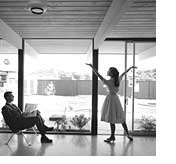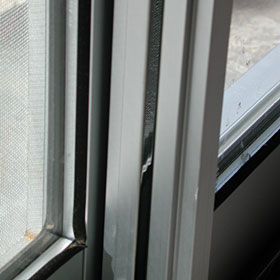Eichler Windows and Doors
 Eichler owners love windows. Of course, they have no choice—they're practically surrounded by them. Some atrium models, in fact, have floor-to-ceiling glass covering more than a third of their exterior walls.
Eichler owners love windows. Of course, they have no choice—they're practically surrounded by them. Some atrium models, in fact, have floor-to-ceiling glass covering more than a third of their exterior walls.
The walls of glass that bring the outdoors in also bring problems. Principal among them is the fact that single-pane glass is a major cause of heat loss, which means increased utility bills (don't blame Eichler; when he was building, "energy conservation" was not much of an issue). If you've replaced your tar-and-gravel roof with one of the insulated varieties, then the windows are one of the only remaining sources of hefty heating bills. The single-pane glass used by Eichler has an R-value (a measure of insulation) of 0.9 to one—a mere fraction of a good roof or properly insulated walls, which can be R-13 or higher.
The solution is easy, but not cheap. Double-pane glass has a sealed airspace between the inner and outer pane. The wider the space, the higher the insulating value (it decreases sound transmission as well). Since still air is a relatively poor conductor of heat, double-pane windows have R-values in the two to four ranges. Using argon or krypton gas between the panes instead of air increases the R-value by about a third.
Low-emissivity (low-E) coatings on window glass further reduce heat transfer. With low-E, a microscopically thin metallic layer allows short wavelength light to pass through the glass while reflecting long wavelength (infrared) energy. Triple-pane windows are available but offer little advantage over modern, low-E double panes, and can be very heavy, requiring thicker framing, a definite no-no in an Eichler.
Homeowners who want to retain the Eichler look in their windows will choose anodized aluminum window frames. Since metal is a good conductor of heat, reduce heat loss by selecting a "thermally broken" frame, which contains a hard plastic barrier between the inner and outer frames.
An alternative approach to increasing the insulating capacity of your windows without replacing them is through an acrylic insert mounted on the inside surface of the glass and attached magnetically to a thin metal frame. Pete Weiss of Noise Solutions, a company which markets an acrylic insert they call the Great Eichler Window, says that the data shows that this system type will boost the R value to 2.2 (depending on the air gap specified). It's less than the best double-pane, but at a significantly reduced cost and reasonably unobtrusive.
With so much glass for Eichler owners to deal with, the cost to raise the insulating value of your old windows can be formidable, and the savings gained in energy costs may not cover the expense of the new windows for decades. Consider focusing on the windows that are the "leakiest"—the single-pane sliding glass doors. After several decades, the effectiveness of the weather stripping in these doors has certainly declined, and it cannot be replaced.
And with original Eichler sliders, weather stripping isn't the only thing that doesn't work like it used to. A major problem is the locking mechanisms, which after years of use invariably fail. Arcadia (800-423-6565, www.arcadiaproducts.com), the manufacturer used by Eichler, no longer makes replacement parts for sliders of 1950s and early '60s vintage. John Wilcox of the Advocate Company (415-307-1944), who overhauls sliders primarily in the East Bay and Marin, reports success in adapting off-the-shelf parts to repair locks.
Other parts that typically wear out are the nylon rollers and track guards, both of which can be replaced. Wilcox recommends switching to a metal roller. (He also suggests that once the homeowner requires maintenance with two or more doors, it will become cost effective to bring him in.) While add-on locks can be installed at the bottom of doors, they are not particularly convenient to use.
 When repair is no longer possible, it's time to replace. Noise Solutions's Weiss carries the latest Arcadia models, but prefers doors made by Peerless (the M-1100 model in particular) as being more solidly constructed. For purists, their only negative is the inside handle, which is partly made of wood. However, it would be possible to get a machine shop to easily fashion a metal handle.
When repair is no longer possible, it's time to replace. Noise Solutions's Weiss carries the latest Arcadia models, but prefers doors made by Peerless (the M-1100 model in particular) as being more solidly constructed. For purists, their only negative is the inside handle, which is partly made of wood. However, it would be possible to get a machine shop to easily fashion a metal handle.
[Right: detail of Peerless sliding glass door showing air gap between double panes and plastic thermal break (vertical black band in center).]
Eichler owners have also found that the Milgard brand makes good quality, minimal-frame windows that blend nicely with modernist architecture. We've also heard good things about their doors. When replacing a slider, try to find a brand—the Peerless is one—that can fit inside the existing door opening, and thus will not mar the minimalist framing.




